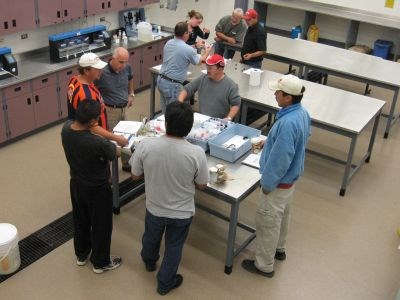Barry Strachan is so confident in the Keewaytinook Okimakanak (KO) Northern Chiefs Council’s Safe Water Project, he’s willing to bet his reputation on it.
“I’ll go on record right now and say we can expect positive change without one dollar being spent on infrastructure,” said Strachan, KO’s public works manager. “We can put a big dent in the number of (boil-water) advisories that are out there.”
It’s a bold statement, but based on the results so far, it’s true.
The Safe Water Project, a multi-pronged initiative introduced in KO’s six member First Nations as a pilot project last April, is a homegrown approach to improving water safety.
It combines training and operational support with state-of-the-art technology to monitor water quality in the communities and address any emerging problems in real time.
Strachan first came up with the idea about 12 years ago, but the federal government of the time rejected his idea in favour of its own Safe Water Operations Program, which brought in third-party operators to monitor the communities’ water.
“It had basically no effect; there was no capacity being built,” Strachan said. “It was like a tenancy had been created. The communities didn’t feel any urgency to do anything about their own water and wastewater issues because they had this third party to look after things.”
When the program was abandoned last year, Strachan saw an opportunity to reintroduce his 12-year-old idea, and KO’s chiefs immediately recognized the benefit of the program.
“We made clear to them that the solution to their problem was in their own hand, that we weren’t fixing it,” Strachan said. “We were going to empower them to fix this themselves and they bought into the premise and turned over authority of their operations to us.”
Since being introduced just over a year ago, the program has already significantly improved the water quality in KO’s communities. Three long-standing boil-water advisories have been lifted, and Strachan is currently trying to get funding to work on a fourth.
Through the program, community members are trained, via a provincially sanctioned course delivered at the Keewaytinook Okimakanak Centre of Excellence in Dryden, to become water treatment plant operators. Much like an apprentice, they have to combine an in-class component and fieldwork to complete their training.
Supervisors are then available to support, mentor, and guide the apprentices to bolster their chance of success.
To date, seven people have achieved a level of certification through the program, while seven more are in progress. Many of those have been youth from the communities, who are realizing a new, important role in monitoring and safeguarding their community’s water source.
“They start owning what happens in their community, rather than relying on somebody else to come and fix things for them,” Strachan said.
The final component of the program is a state-of-the-art water-monitoring system developed for KO by Airborne Underwater Geophysical Systems out of Toronto. The Triton Intelligence Water Surveillance system delivers water quality results in real time, which differentiates it from other systems on the market.
Data delivered to water treatment operators is received no more than two minutes after readings are taken — a far cry from the two to three days it used to take to get results.
“If there’s an issue, we know immediately, so we’re not exposing people for prolonged periods of time to bad things in the water,” Strachan said. “So it’s a huge improvement to how we’ve been doing things.”
As word spreads of the success of the program, Strachan is receiving interest from other communities, and he’s awaiting word on federal government funding that would extend the program and secure its future.
Whether the concept can be commercialized is another story. KO is a not-for-profit enterprise and its main goal is to improve the health of its residents by improving its communities’ water quality.
But Strachan would like to see KO’s program evolve into first certified Aboriginal water and wastewater agency in Canada. He also believes there’s an opportunity to commercialize the Triton water-monitoring technology and bring its production to the North.
“As this grows, we hope to integrate the manufacturing of the equipment into Dryden to give the city here a bit of an economic boost,” he said. “I think that’s an important spinoff of what we’re doing.”
He recognizes that, by training KO’s citizens in what is becoming a growth industry, KO risks the chance of losing some of its most highly trained people: their qualifications allow them to work just about anywhere.
“We always run the risk of losing some of our folks, but we’ll continue to train them as long as the need is there.”




